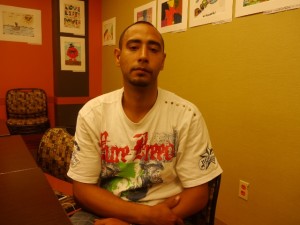
Photo by William Mathis
In 2011, Edwin Rivera was serving time in the Bear Hill Correctional Facility in upstate New York when he learned about a new drug. “We started hearing about it,” Rivera said. “People were talking about this new thing, K2.”
K2, a nickname for synthetic marijuana, has become the new “it” drug in the northwest Bronx. Rivera’s story, complete with moments of hallucinations, explains why K2 has been popularized despite its harsh and unpredictable effects.
The state of New York banned the sale of K2 back in 2012 after a number of its users were hospitalized. However, many bodegas, including 14 in the 52nd Precinct covering Norwood and Bedford Park, continue to freely sell synthetic marijuana over the counter under various names, all labeled as potpourri or incense, and not for consumption.
These days, Rivera, 33, is drug free and living at VIP Services, a men’s residential rehabilitation center in the Tremont area of the Bronx, a condition of his parole. A recovering heroin user with a stint in prison for burglary, Rivera turned to K2 after readjustment on the outside proved challenging. “Nobody wanted to listen,” he lamented. “So I started getting high.”
But Rivera could not take conventional drugs; drug tests can detect those. So instead of going to a dealer, he walked from the rehabilitation center down to the bodega a few blocks away on the corner of East Tremont and Third avenues to purchase some K2. “I felt like I was getting away with smoking weed because there was no test for it,” Rivera said.
He began to smoke K2 regularly, two joints every hour each day. Unlike many illegal drugs, even such a heavy addiction was not prohibitively expensive. A packet of K2 costs between $4 and $5, with each packet containing enough for a 10 to 15 average hit.
Part of the reason K2 is so hard to detect and also criminalize, is because it is hard to know for sure what each packet contains. Manufacturers repeatedly change the chemical makeup to evade evolving drug laws. As a result, users have no way of knowing for sure what they are ingesting. “It could be dog poo in there,” Rivera admitted.
There are also few statistics on the number of users out there.
“I call it the “loophole” drug,” said Debra Vizzi, executive director of VIP Services. “It’s one step ahead of us. As a result, we can’t determine adequate numbers of usage, and some researchers are lumping it with cannabis and not a separate study.”
The effects of the high are just as unpredictable. “K2 is similar to an angel dust high,” Rivera said. “Some people might see roaches or demons.” Once while visiting his mother in Brooklyn, he saw a woman, high on K2, hit a young girl all over her body. When bystanders intervened, the woman said she had seen bugs crawling all over the child and was trying to swat them off.
Rivera also experienced its side effects too. A few months ago he woke up after a heavy dose of K2. He could not remember what had happened, but later learned that he collapsed and experienced a seizure. He still bears scars on his hand from where his convulsions banged it against the ground.
Now, Rivera is clean again. A couple of months ago, he started waking up in a heavy sweat and stomachaches, reminiscent of the pains he used to feel waking up in withdrawal from heroin. Unwilling to be an addict again, he sought help and went through a 21-day detox program at an inpatient clinic in upstate New York.
Rivera thinks the government should do more to fight K2 use. “They should really make it illegal,” he said. “They should crack down on stores.”
This fall, the city government will try to do just that. City Council will propose a new law that could impose penalties from a year in jail to a $5,000 fine for K2 vendors. Law enforcement officials have also stepped up their efforts in containing the spread of the drug. The U.S. Attorney for the Southern District of New York, Preet Bharara, recently indicted ten members of a K2 distribution ring that sold an estimated 260,000 units of the drug in all five boroughs since September 2014. The men allegedly imported illegal chemical compounds from China to a processing facility on Light Street in the Eastchester neighborhood of the Bronx. The men then sprayed the materials onto tea leaves, packaged the processed leaves and distributed the packets to 80 bodegas throughout the city.
Still, Rivera knows that drugs in the city are no easy problem to solve. “An addict is an addict,” he said. “If an addict can’t get one drug, they going to turn to something else.”




